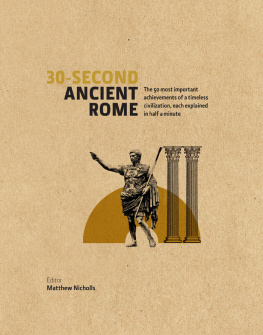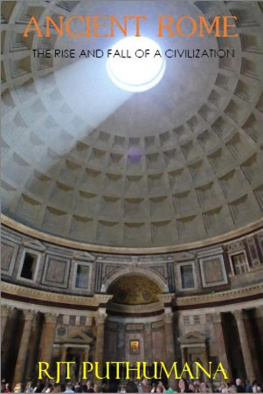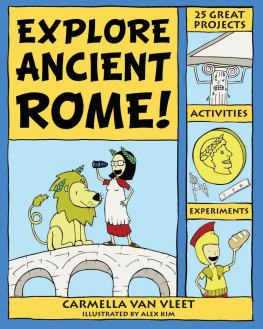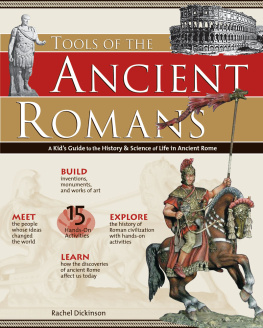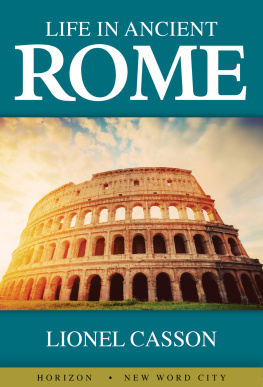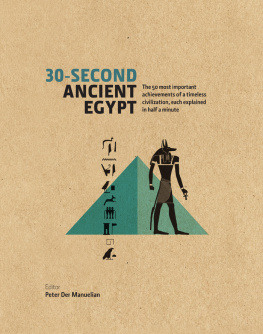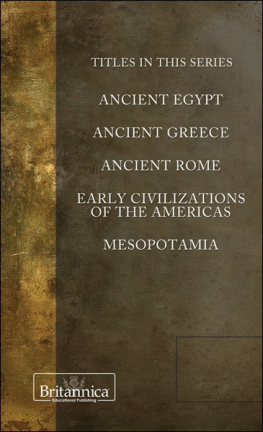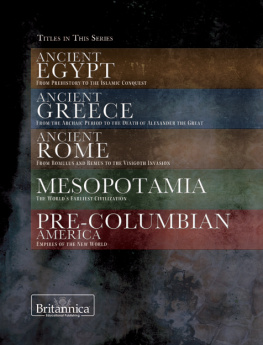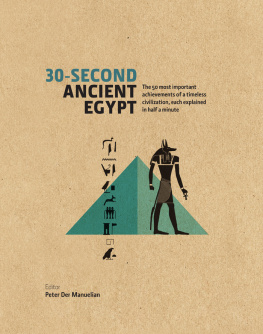
30-SECOND
ANCIENT ROME
The 50 most important achievements of a timeless civilization, each explained in half a minute
Editor
Matthew Nicholls
Contributors
Luke Houghton
Ailsa Hunt
Peter Kruschwitz
Dunstan Lowe
Annalisa Marzano
Matthew Nicholls
Susanne Turner

You know that Rome wasnt built in a day, but just how did a cluster of small hilltop villages expand to become one of the greatest empires in history? Why did Romulus kill his brother Remus? How was a legion organized? Did people really speak Latin? What entertainment could you see at the Colosseum? And what was daily life like for a Roman citizen? This book takes a novel approach to answering all these questions and more.
30-Second Ancient Rome presents a unique insight into one of the most brilliantly governed societies, where military might and expansive empire paved the way for technological advances that helped shape our modern existence. From aqueducts to sewers, from mosaics to medical diagnoses, this is the straightest road toward understanding the 50 key innovations and ideas that developed and defined one of the worlds great civilizations.
CONTENTS
INTRODUCTION
Matthew Nicholls
Traces of the huge Roman empire remain all over Europe, from northern Britain to Syria and the coast of north Africa. Anyone who walks the length of Hadrians Wall, for example, following it for the 80 miles (130 km) or so from coast to coast through the windswept countryside of northern England, is traveling through what was once a far-flung Roman frontier. Yet even here, hundreds of miles north of Romes Mediterranean heartland, there is much of Rome in evidence. The Wall itself, and its string of neat, symmetrical forts, with characteristic bathhouses and headquarters buildings, speak of the power and organization of the Roman army, and its formidable architectural and technological capacityand also of Romes desire to impose itself on new territory, by force if necessary. In and around these outposts, finds of pottery, coins, clothing, altars, and even private letters show how the soldiers and settlers brought with them ways of living, eating, trading, worshipping, thinking, and writing that began to transform Britainalong with many other parts of Europe, north Africa and the Middle Eastinto a Roman province, leaving a lasting legacy. Such small finds from this great military monument also remind us that historical events are made up from thousands of smaller, private, stories.

Marcus Tullius Cicero, Roman statesman, philosopher, lawyer, and scholar. Remembered as one of the greatest orators and his writings are the epitome of Roman Prose.
This picture is repeated at hundreds of sites, military and civilian, public and private, all over the empire. We also have a rich body of surviving literature from Roman times, transmitted over the centuries in copies of copiesso we can set Hadrians Wall in its context by reading what ancient historical writers and poets said about Romes conquest of Britain. From epic poetry to history, from speeches to medical treatises to recipes, this rich body of literature allows scholars to explore very different aspects of Romes long and colorful historyand newly discovered texts are still turning up, in the dry sands of Egypt, in carbonized books from Herculaneum, and in old libraries.
The Roman empire still imposes on to the modern world with Hadrians wall, the defensive fortification in northern England, cutting its way across the landscape nearly 2000 years since its creation.


This study reveals a fascinating people. At times the Romans can seem similar to us, with their concern for home comfortscentral heating, proper water supplies, and drainsand their passion for urban life, for good communications, for fine food and wine, for literature, entertainment, and status. But they were also very different. Think of slavery and gladiatorial combat, their world of gods and sacrifices and worship of the living emperor. The grand statues and monuments that filled their public spaces set the mold for many modern cities, but speak of a triumphalism that has now fallen from fashion. In truth, the Romans were both familiar and foreign, which makes the study of their lives and times endlessly fascinating. The contributors to this book ably and enthusiastically take on the challenge of bringing to vivid life the very best and the worst of this ambitious, inventive, cultured, and at times brutal and licentious episode in western history.
An overview of Roman history
The history of ancient Rome lasted well over a thousand years, from its legendary foundation on April 21st 753 BCE through to the fall of the (western) Roman empire on September 4th 476 CE . Its empire covered much of Europe and parts of north Africa and the Middle East. Its legacy in almost every area of human activity remains to the present day.
This huge span of geography and history can be hard to navigate, but the timeline here shows some major landmarks in Roman history and provides a framework of reference for the rest of the book. Likewise the map, which shows the empire at its greatest extent in the early second century CE , locates Rome itself and charts the Mediterranean world in which its influence eventually spread from the draughty outpost marked by Hadrians Wall to the borders of modern Iraq.

753 BCE Foundation of Rome
Legendary foundation datebut, according to some modern archaeology, not far off the mark.
509 BCE Formation of Roman republic
Expulsion of the last of Romes kings: a new republican constitution delivered safeguards against excessive individual power.
fifththird C BCE Growth of Roman power
Roman power spread across Italy through warfare and treaties.
264146 BCE Punic Wars
A series of three draining wars against Carthage, Romes greatest rival; final victory allowed Romes Mediterranean empire to expand.
ca.13344 BCE Crisis of the republic
A period of unrest and repeated civil war, as Romes republican constitution struggled to contain imperial expansion, individual political ambition, and inequality.
6053 BCE First triumvirate
Political alliance of three of Romes greatest figures: Caesar, Pompey, and Crassus.
March 15th, 44 BCE Death of Julius Caesar
Romes dictator felled by senators resentful of his dominance, triggering further civil war.
31 BCE 14 CE Reign of Augustus
Romes first emperor. Expansion and consolidation of empire; foundation of a long-lived system of one-man rule.
31 BCE 68 CE Julio-Claudian dynasty of emperors
Augustus, Tiberius, Caligula, Claudius, and Nero.
6897 CE Flavian dynasty
Vespasian, Titus, and Domitian.
Next page
